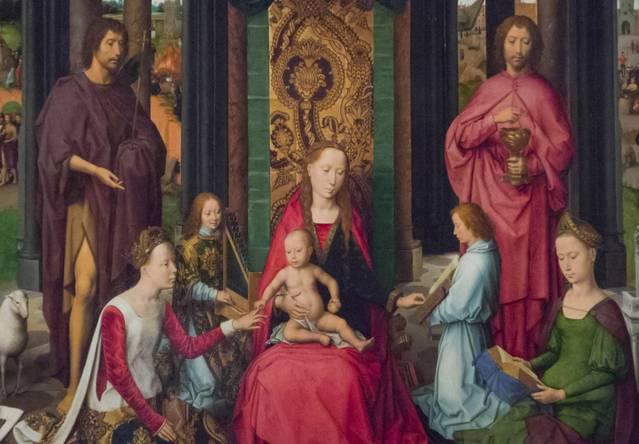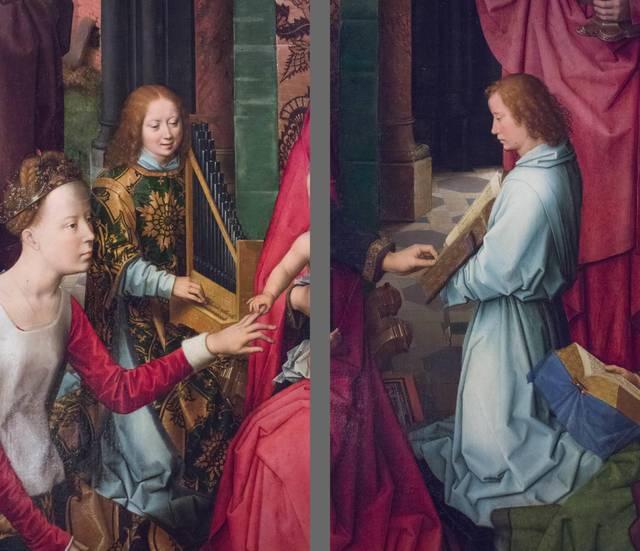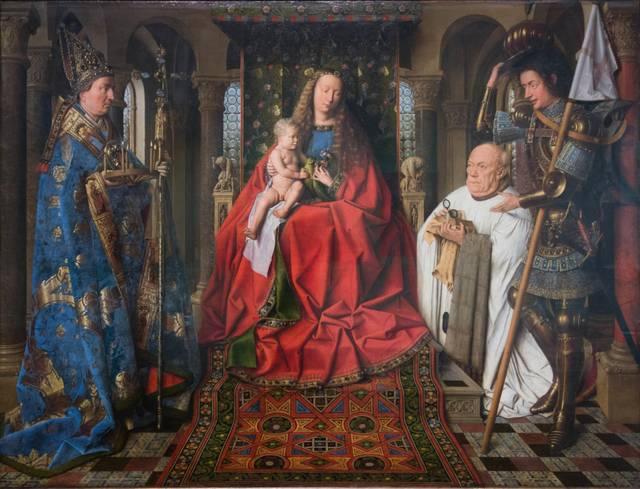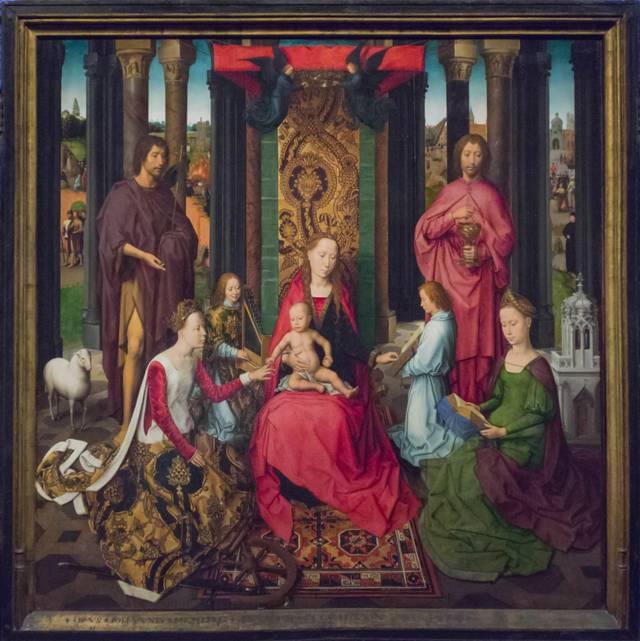a sacred conversation
sacred conversation in the central panel scene
To Mary's coronation, the presence two by two of Catherine of Alexandria and Barbara the Great Martyr, John the Baptist and John the Evangelist adds a «sacred conversation», that is, a meeting of saints around the Virgin.

the two altar servers in the scene of the central panel
This spirit of communion is reinforced by the presence:
- on the left of the Virgin of a altar server who plays a small organ seated,
- and on the right of another kneeling who presents her with a book.

Sacred conversation, a remarkable expression of “devotio moderna”
symmetry, simplicity, distinction in the arrangement of the protagonists
symmetry, simplicity
The symmetry and simplicity of the positions in relation to each other in the width matches the shape of the tryptic.
distinction
The height and depth organize themselves around the distinction between men and women:
- on the front below, two women,
- on the back in the upper part, two men.
The unfathomability and mystery in depth and height responds to the symmetry and simplicity of the width positions
similarities of physiognomies, variety of ages represented
The characters depicted appear to be from the same family and are of all ages:
- newborn,
- small child,
- child,
- teenager,
- young man,
- woman,
- mother,
- man,
- mature man and woman.
The similarity of the physiognomies and the variety of ages unifies the whole.

“devotio moderna”, a movement to reform the Christian faith in Flemish society in the 15th century
We believe that this balance is a remarkable feature of the 15th century Flemish society in which Memling lived.
The very important Christian faith reform movement of this period, which historians call “devotio moderna”, illuminates that familiar simple transparency of represented space.
“devotio moderna”
In Flanders, at the time of Memling, for a book of Christian piety, “The imitation of Jesus Christ”, is a huge publishing success note 6 .
text from The Imitation of Jesus Christ
One can read:
- Man rises above the earth on two wings, simplicity and purity.
- Simplicity must be in intention, and purity in affection.
- Simplicity seeks God, purity finds him and taste him.
- No good work will be difficult for you if you are free of any disturbed affection.
- If you only want what God wants and what is useful to the others, you will enjoy inner freedom.
- If your heart was right, then any creature would be a mirror of life to you and a book filled with holy instructions.
- There is no creature so small and so vile that would not present some image of the goodness of God.
- If you had enough innocence and purity, you would see everything without impediments.
- A pure heart penetrates heaven and hell.
- Anyone judges of things from the outside according to what he is within himself.
- If there is some joy in the world, the pure heart owns it. And if there are anxieties and tribulations, above all they are known from bad conscience.
- As the iron put on fire loses its rust and becomes blazing, so the one who gives himself unreservedly to God remains his languor and changes into a new man.
In the scene depicted by Memling, the sacred conversation functions in the terms of the text quoted above as a book filled with holy instructions
simple, pure, in accordance with the architectural plan.
architectural plan
the “devotio moderna”, mode of relationship between the protagonists of the represented scene and spectators
The arrangement of the places represented, the apse of a church, allows the architectural device to function also in relation to the spectators of the triptych.
We who look at the painting find ourselves de facto in the space of the painting, part of the sacred conversation, in the presence of the protagonists of the scene represented, in this relationship of simple, transparent, familiar otherness.
From this point of view, Memling's work functions as a mirror of life:
- On the one hand the viewers of the triptych, whether they were patients at St John's Hospital in Memling's time or us today “conversing” with the figures depicted,
- on the other these “act” here and now, as Bruges men and women of or visitors to the Memling Museum of the 21st century.
devotio moderna, crystallisation of the marvellous of Bruges in the 15th century
Finally, the exemplary arrangement of a representation in which the figures are adorned with the finest sartorial achievements of 15th century Bruges, crystallises the sense of wonder.
spiritual simplicity, evidence, ideality also produce in a continuous way material sophistication and opulence.
Dirk DE VOS mentions:
“a world of virgins clad in gold brocade, silk and ermine, golden crowns and rare precious stones” where "the infant Jesus beckons" to the sick in an "atmosphere imbued with profound serenity".
In fact, in Bruges in the 15th century, simplicity and the obvious knew no bounds, leading wonderfully to the divine.
the influence of Van Eyck on the architectural plan
Memling is undoubtedly guided by this work by Jan VAN EYCK painted in , which he knows and will admire in the St. Donatian Cathedral: “Virgin and Child with Canon van der Paele”.

Memling's innovation on the architectural plan compared to Van Eyck
As in many of his other works, Memling removes to the apse walls, windows and makes the view to the outside continuous.

Six columns marbled with red and brown are arranged in a semi-circle on a tile and doubled on the outside by a second semi-circle of fasciculated dark grey pilasters. Their bases are connected by the edge line of the paving which shows a polygon on the ground.
The thin vertical openings between the columns overlook a visually continuous landscape with ruins and buildings, open to the distant, horizon and infinite.